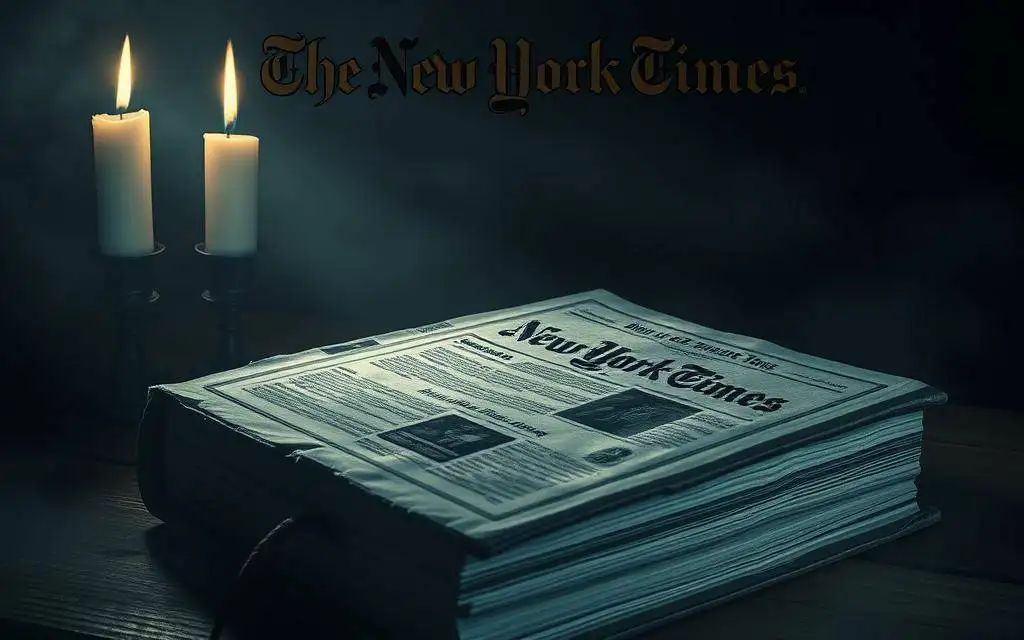I’ve always been drawn to the New York Times’ spooky stories. The NYT is known for its chilling tales that make readers shiver. Exploring their horror stories, I found a world of supernatural tales that have captivated readers for years.
Spooky stories in the NYT are more than just fun. They dive into the human mind, showing the line between what’s real and what’s not. The New York Times has always brought readers spine-tingling content that sparks their imagination.
In these stories, you’ll see how horror journalism has grown. You’ll learn how these tales affect our minds and the authors who create them. It’s a journey into the heart of horror storytelling.
Key Takeaways
- NYT offers a comprehensive collection of spine-tingling stories
- Horror journalism explores deeper psychological themes
- Supernatural narratives have rich historical roots
- New York Times continues to innovate in horror storytelling
- Spooky stories provide unique insights into human fears
The Evolution of Spooky Story NYT Collections Through the Years
Exploring the archives of the New York Times shows a captivating journey of vintage horror journalism. For many years, the New York Times has shared spine-tingling stories. These stories mix journalism with supernatural mystery.
The world of supernatural reporting has changed a lot over time. I’ll look at how ghost stories were documented and shared through different eras.
Early Ghost Stories from the Times Archives
In the late 19th century, horror journalism started in newspaper columns. Reporters mixed skepticism with curiosity in their stories. The early ghost stories in the New York Times were like investigative pieces, full of detail and precision.
- Supernatural reports were treated as potential news stories
- Eyewitness accounts received careful documentation
- Paranormal events were analyzed with scientific curiosity
Digital Age Horror Tales and Modern Reporting
The digital revolution changed how ghost stories are shared. Online platforms expanded the reach of supernatural narratives. This allowed for more immediate and interactive reporting of paranormal experiences.
Notable Authors and Their Contributions
Legendary journalists and writers have shaped ghost story reporting. Their unique approaches added credibility and depth to supernatural stories.
The art of reporting ghost stories is as much about understanding human psychology as it is about documenting unexplained phenomena.
From typewritten manuscripts to digital archives, the New York Times has saved an amazing collection of supernatural stories. These stories continue to intrigue and mystify readers across generations.
Psychological Impact of Reading Horror Journalism

Horror stories do more than just entertain. They take readers on a deep emotional journey. This journey triggers strong psychological reactions. Our brains release special chemicals when we read scary stories, making the experience intense.
Why do people enjoy horror journalism? It’s because of some interesting psychological reasons:
- Adrenaline rush provides a safe emotional exploration of fear
- Controlled exposure helps develop emotional resilience
- Neurochemical responses create a sense of excitement and relief
Studies show that horror content has real benefits. The NYT’s scary stories let readers feel fear safely. They can explore scary scenarios without real danger.
“Fear is a powerful emotional experience that connects readers to deeper human experiences,” says Dr. Elizabeth Roberts, psychological researcher.
The NYT’s approach to scary stories shows that facing fear in a controlled way can:
- Reduce anxiety in real-world situations
- Enhance emotional intelligence
- Provide cathartic emotional release
| Psychological Response | Emotional Impact | Duration |
|---|---|---|
| Adrenaline Surge | Excitement | Immediate |
| Cortisol Release | Stress Management | Short-term |
| Dopamine Activation | Pleasure | Post-experience |
Horror stories can be intense, but good journalism keeps readers safe. The NYT’s stories offer a way to understand complex human experiences through fear.
Conclusion
The New York Times’ nyt horror legacy is more than just scary stories. It shows how these tales go beyond regular news, touching on our deepest fears and curiosities. The Times has been amazing at telling these stories, from old ghost tales to new digital horror.
Looking ahead, technology will change horror journalism a lot. Digital tools let readers dive into stories in new ways. The NYT is keeping up, mixing old-school reporting with new ways to tell stories that people love today.
The New York Times is a leader in horror journalism. It shows that these stories are more than just fun. They give us a peek into our minds, our culture, and what makes us feel.
Exploring NYT’s horror stories shows their dedication to quality and creativity. They keep making stories that grab readers of all ages. The Times uses new ideas and strict journalism to keep spooky tales alive and important in our culture.

